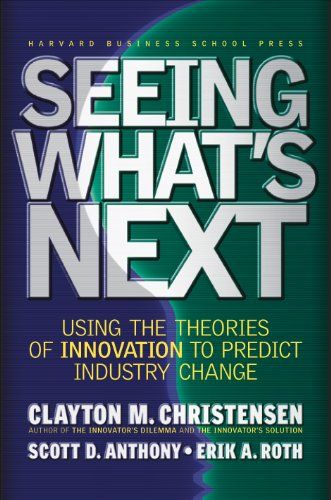Seeing What’s Next: Using the Theories of Innovation to Predict Industry Change – Clayton Christensen

“Seeing What’s Next: Using the Theories of Innovation to Predict Industry Change” discusses how businesses can use the theories of innovation to predict future industry changes and stay ahead of their competition
The jobs-to-be-done framework
The jobs-to-be-done framework is a way to understand the fundamental needs and desires of customers, and how these needs might change over time. By focusing on the job that customers are trying to accomplish, businesses can identify opportunities for innovation and disruption.
Understanding customer adoption
Customer adoption is the process by which customers learn about, try, and ultimately adopt new products or services. By understanding the factors that influence customer adoption, businesses can design products and marketing strategies that encourage widespread adoption.
The role of disruptive entrepreneurs
Disruptive entrepreneurs can play a key role in driving innovation by challenging the status quo and creating new markets. By supporting and nurturing disruptive entrepreneurs, businesses can position themselves for long-term success.
Anticipating future industry changes
By understanding the underlying trends and forces that shape an industry, businesses can anticipate and prepare for future changes. By constantly monitoring industry developments and adapting to new trends, businesses can stay ahead of the curve and maintain a competitive advantage.
The role of resources and capabilities
Resources and capabilities refer to the assets and skills that a company possesses. By leveraging their resources and capabilities in innovative ways, businesses can create unique value propositions and differentiate themselves from competitors.
The theory of disruptive innovation
The Theory of Disruptive Innovation explains how new technologies or business models can disrupt existing markets by initially serving a niche market, and then gradually expanding to compete with established players. By understanding this theory, businesses can better anticipate and respond to disruptive threats.
The power of networks
Networks can play a key role in innovation by connecting different players in an industry and facilitating the exchange of ideas and resources. By building strong networks, businesses can stay up-to-date on industry trends and collaborate with other companies to create new value.
The impact of regulations
Regulations can have a significant impact on the success of new products and services. By understanding the regulatory environment in which they operate, businesses can identify potential opportunities and risks, and develop strategies to navigate this complex landscape.
Sustaining vs. disruptive innovation
Sustaining innovation refers to incremental improvements to existing products or services, while disruptive innovation refers to the creation of new products or services that fundamentally change the way things are done. By balancing both types of innovation, businesses can maintain their current position while also preparing for the future.
The importance of business models
A business model describes how a company creates, delivers, and captures value. By understanding their own business model and those of their competitors, businesses can identify potential areas for innovation and develop strategies for long-term success.



Comments ()